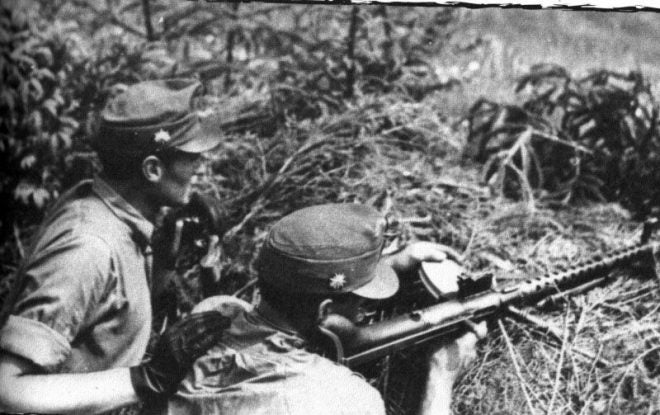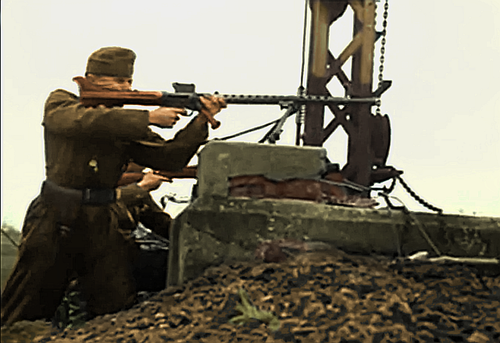A central powers stew
The story of how Hungary came to equip its armed forces with Swiss machine guns, like many origins in WWII, goes back to WWI. The treaty of Versailles prohibited or significantly inhibited arms production by any former Central Powers countries, Hungary being one of them. Many small arms designers impacted by the same regulations turned to outside countries to circumvent these regulations, Switzerland being a favorite choice of the Germans. Therefore Louis Stange (whose resumé also includes the FG42, MG39Rh, MG 81, MG 15, and the MG 34) of Rheinmetall took his MG 30 design to Switzerland to be produced by Solothurn Waffenfabrik (A company which was in itself a bit of a Rheinmetall creation).
The MG 30

The MG 30, note position of gunners support hand on the hook of the buttstock
The MG 30 looks at first glance like a tubular MG 42. It was recoil operated via a heavy return spring in the buttstock, air-cooled, and has a dual trigger with provisions for semi or full automatic fire. It had a side mounted 30 round magazine and a rear sight adjustable for 100-2000 meters. Weighing only 18.5lbs when equipped with a bipod, it falls into the “light machine gun” class of weapons. Notably, there is a prominent hook on the forward toe of the buttstock that allows the gunner’s support hand more leverage on the buttstock. Cyclic rate of fire was a very controllable 450 rpm. Production took place from the early to mid-1930s.
Hungarian acquisition and Modifications
Hungary, being severely affected by the Treaty of Trianon, had major impositions on its domestic arms development which led to their purchase of the German-designed, Swiss-produced machineguns. They purchased approximately 2,500 MG 30s with one significant modification: They required the guns to be rechambered in 8x56mmR, which changed the magazine capacity to 25 rounds. The 8x56mmR M30 cartridge was developed by Steyr in Austria, and pushed a 206gr FMJ at 2,300 ft/s. The new designation for the MG 30s sold to the Hungarian army was “Solothurn Golyózóró 31.M.”.
In 1934, the 31.M was modified with a larger magazine and a higher rate of fire for aircraft use. Much like the German modification of the MG 30 to the MG 17, a muzzle device was added to boost ROF to 1,000 rpm, and feeding was modified to a double drum magazine that would feed each round alternatively from either side.

Hungarian Mountain Troops (note the edelweiss on the side of their cap) fire the 43.M
In 1943, Hungary standardized to the 7.92x57mm Mauser cartridge. All 31.M guns were converted by rebarreling to 7.92×57 with a corresponding 30 round magazine, and newer guns were given the designation “Solothurn Golyózóró 43.M.”. Production of new guns was accomplished at both the Fémáru and Danuvia factories around Budapest.
The 31.M and later the 43.M saw service widely throughout Southern and Eastern Europe throughout Hungary’s involvement in World War 2, beginning with the Hungarian involvement in the invasion of its erstwhile ally Yugoslavia until the end of the war in Europe. Though the 31.M and 43.M are less well known than their more famous 20mm Solothurn S/18 series, they still were a significant part of Hungarian armament in WWII.
For a more in-depth look at the MG 30 and Guns of Louis Stange, please visit Forgotten Weapons, where Ian will drop some serious knowledge on you.
 Your Privacy Choices
Your Privacy Choices
